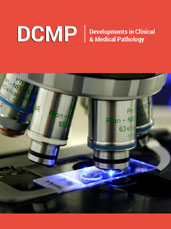- Submissions

Full Text
Developments in Clinical & Medical Pathology
Molecular Methods of Testing Tuberculosis Reviewing the Method of Molecular Diagnosis of Mycobacterium in Infected Patients for Treatment in India
Deva Rupal*
Pune University, India
*Corresponding author: Deva Rupal, Professor, Pune University, 1400 Part 1 scheme 114, Vijay Nagar, Indore, India
Submission: March 3, 2018;Published: May 15, 2018

ISSN:2690-9731 Volume1 Issue2
Editorial
This article complies the work that was done which should be further continued may for newer diagnosis of Mycobacterium infected patients India up to level of species to enable clinicians to prescribe the right diagnosis and treatment the suspects of TB for the “The war against Tuberculosis through diagnosis and treatment”. It is important to be able to identify type of Mycobacterium at species level especially the resistant MDR (multiple Drug Resistance ) and XDR( extreme Drug Resistance) strains in patients to find the resistance at the level of genes, which can be done using molecular biology line probe assay methods as described earlier Vlaspolder et al. [1]. Apart from classical methods of diagnosis of and combination of modern methods of microbiology, pathology and biochemical methods it was possible to identify the infecting organism using modern developed method as published previously by Deva. R et al. [2], and It was even possible too to identify the latent TB Infection in patients giving the warning signs of existing strais in the population hidden in body. The identification of Multiple Drug Resistant bacteria (MDR) and XDR TB (Exreme Resistant bacteria) as well which contributed to the hospital spread TB infections, need to be identified as early as possible to start the treatment of infected patient to kill each bacteria before it spreads in the community. Multi drug resistant tuberculosis (MDR-TB) as well as XDR TB bacteria leading to the disease, which requires a quick identification and the fast treatment by clinicians to prevent it to spread in society of country. The organism resistance to Isoniazid or Rifampicin, which may not show resistance to other anti-TB drugs among new cases, as well as in the previously treated ones as reported by WHO [3], need to be reported to the Health organization to have a shorter regimens of therapy which is needed for the treatment of the patient. Diagnostic Research and the evidence becomes the fundamental for beating the tuberculosis disease. The diagnosis of genes first line drug resistance line array for identification of Drug sensitivity/resistance in Mycobacteria by identification of RPO, INH A, Kat G genes in Mycobacterium. Tuberculosis 2nd line drug resistance Line array for identification of Drug sensitivity/ resistance in Mycobacteria with identification of GGRA, RRS and Embb gene in Mycobacterium tuberculosis and Identification of MOTT by Analysis of GC- rich gram positive bacteria can be done by molecular linear array as described previously [4]. Clinician aim to reduce the contribution of patients harboring in spread of infection of Mycobacterium Species at all the levels including 1st level 2nd level to stop the Mycobacterium becoming totally resistant strain resistant to every known medication also their combinations through by the quick and right diagnosis. The aim of the group was to contribute to screen every infected patient and to provide the therapy for clinicians’ war against Mycobacterium, utilizing automatic molecular biology based methods, Identified My National Board of Accreditation (India) (NABL) for quality diagnosis and treatment.
References
- Vlaspolder F, Singer P, Roggeveen C (1995) Diagnostic value of an amplification method (Gen-Probe) compared with that of culture for diagnosis of tuberculosis. J Clin Microbiol 33(10): 2699-2703.
- Deva Rupal, Songara, Prafulla, Neema Sushma, Kothari Vineeta, et al. (2014) An interdisciplinary methodological approach for the diagnosis of tuberculosis in the Central state of India. IOSR Journal of Dental and Medical Sciences 1(10): 20-30.
- Bajpai I, Shashank M, Gaur R, Kothari V, Deva R (2015) Latent TB detection and isolation of MDR TB bacteria in, MP, India. Clin Microbiol 4(1): 1-5.
- Halder A, Jose R (2014) Maternal mortality and derivations from the WHO near-miss tool: An institutional experience over a decade in southern India. J Turkish Ger Gynecol Assoc 15(4): 222-227.
© 2018 Deva Rupal. This is an open access article distributed under the terms of the Creative Commons Attribution License , which permits unrestricted use, distribution, and build upon your work non-commercially.
 a Creative Commons Attribution 4.0 International License. Based on a work at www.crimsonpublishers.com.
Best viewed in
a Creative Commons Attribution 4.0 International License. Based on a work at www.crimsonpublishers.com.
Best viewed in 







.jpg)






























 Editorial Board Registrations
Editorial Board Registrations Submit your Article
Submit your Article Refer a Friend
Refer a Friend Advertise With Us
Advertise With Us
.jpg)






.jpg)














.bmp)
.jpg)
.png)
.jpg)










.jpg)






.png)

.png)



.png)






